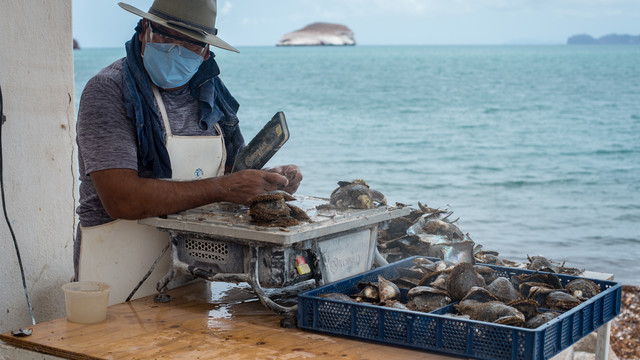The ecosystem approach: a holistic perspective to marine biodiversity conservation
A new briefing by IIED and the Norwegian Centre for the Law of the Sea explores the implementation of the ‘ecosystem approach’ in the international legally-binding treaty to protect marine biodiversity.

A high-endemism deep reef fish community in Kure Atoll, Hawaii (Photo: NOAA and Richard Pyle/Bishop Museum via Flickr, CC BY-NC 2.0)
Described as a “strategy for the integrated management of land, water and living resources”, the ‘ecosystem approach’ recognises that humans, with their cultural diversity, are an integral component of ecosystems and promotes conservation and sustainable use in an equitable way.
The approach has been acknowledged by those negotiating a new international treaty on the conservation of marine biodiversity in areas beyond national jurisdiction (ABNJ) – areas of ocean over which no single country has authority or rights – as a key part of efforts to implement more effective and sustainable governance of the high seas. Yet, its role is still ambiguous.
The negotiators of the treaty still need to agree how the approach will be incorporated in the new treaty, and articulate clear guidance on putting it into practice.
Helpfully, a new briefing by IIED and the Norwegian Centre for the Law of the Sea (NCLOS) considers how the ecosystem approach should be integrated in future legislation to become an effective guidance of marine conservation.
The publication highlights four key elements on which the ecosystem approach is based:
- Ecological integrity: the overarching aim is to preserve key functions and components of ecosystems to protect and conserve their biodiversity
- Integration: conservation activities need to be all-inclusive and encompass ecological interdependencies and connections
- Information: the use of detailed knowledge around ecosystems is key to assess whether a conservation plan or measure is effective, and
- Iteration: conservation measures need to be constantly assessed in order to respond successfully to changes in the ecosystems.
“From the process’s early stages, the ‘ecosystem approach’ was identified as an invaluable tool that would help avoid fragmentation and build a global legal regime that allowed for an integrated assessment of human activities and their interactions with the marine environment,” says Vito De Lucia, an associate professor at NCLOS and author of the publication.
“However, the approach’s potential role remains unclear.”
The briefing sets out four steps that negotiators should take to ensure the effective implementation of the ecosystem approach, including how the planned new treaty should explicitly acknowledge and incorporate the social, economic and equity dimensions of the ecosystem approach.
"An ecosystem approach that stops at the jurisdictional boundary between areas within and beyond national jurisdiction falls well short of its conceptual and ecological ambitions” – Vito De Lucia
The key policy points also include the need for negotiators to ensure both national and international jurisdictions, as ecosystem boundaries traverse often jurisdictional lines. And IIED and NCLOS call for negotiators to reach a consensus on how the approach will be introduced and articulated in a new treaty, considering a coherent application and compatibility with existing treaties.
The briefing has been produced as part of IIED’s work on ensuring an inclusive blue economy.
Contact
Annabelle Bladon (annabelle.bladon@iied.org), researcher, IIED’s Shaping Sustainable Markets research group


